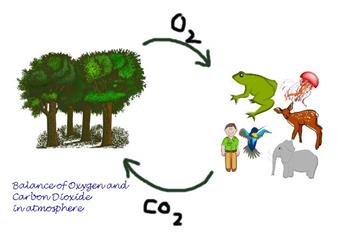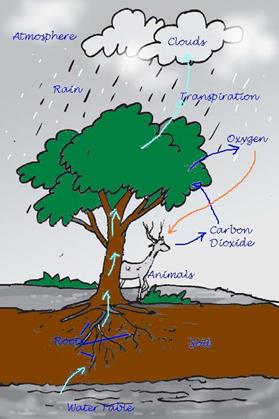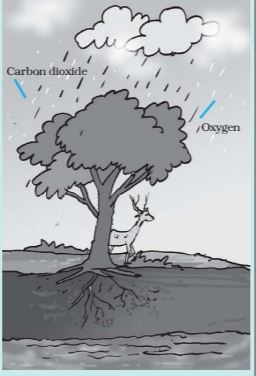Forests Our Lifeline - Solutions
CBSE Class–VII Science
NCERT Solutions
CHAPTER-17
FOREST: OUR LIFELINE
Question 1. Explain how animals dwelling in the forest help it grow and regenerate.
Answer: Animals dwelling in the forest help in various way for growth and regenerate. Some of them are:
(i) Herbivores animals clear the land by eating grass for the new growth of vegetation.
(ii) Animals also help in the seed dispersal and pollination.
(iii) Dead and decaying bodies of animals convert to humus after decomposition which increase the fertility of the soil of the forest.
(iv) Dung of animals provide nutrient to various types of seedling to grow.
Question 2. Explain how forests prevent floods.
Answer: Forest acts as a natural absorber of rainwater and allows it to seep. It helps in controlling the flow of water and slows it down which helps in preventing flood. Also, the trees present in the
forest prevents the rain from directly hitting the ground and bind the soil together which helps in absorption of the rain water and thus prevent flood.
Question 3. What are decomposers? Name any two of them. What do they do in the forest?
Answer: The micro-organisms which convert the dead plants and animals to humus are known as decomposers. Bacteria. Mushrooms etc. are common decomposer. They decompose dead organisms and provide nutrient to trees.
Question 4. Explain the role of forest in maintaining the balance between oxygen and carbon dioxide in the atmosphere.
Answer: Plants release oxygen as a by product during the process of photosynthesis. This oxygen is inhaled by animals for respiration. This respiration process releases carbon dioxide which is used again by plants during photosynthesis. In this way, use and consumption of oxygen and carbon dioxide goes on. They thus maintain the balance of oxygen and carbon dioxide in the atmosphere.
Question 5. Explain why there is no waste in a forest.
Answer: There is no waste in a forest because whatever produced here are utilized by the other organisms or plants for sustainability. Even the waste materials and dead remains which are produced are biodegradable and converted into humus which returns back to the soil as nutrient.
Question 6. List five products we get from forests?
Answer: Products that we get from forests includes:
(i) Wood
(ii) Medicine
(iii) Spice
(iv) Fodder
(v) Honey
Question 7. Fill in the blanks:
(a)The insects, butterflies, honeybees and birds helps flowering plants in --------.
(b)A forest is a purifier of ------------ and ---------------.
(c)Herbs form the ------------- layer in the forest.
(d)The decaying leaves and animals dropping in a forest enrich the ------------.
Answer: Fill in the blanks:
(a)The insects, butterflies, honeybees and birds helps flowering plants in pollination.
(b)A forest is a purifier of air and water.
(c)Herbs form the ground layer in the forest.
(d)The decaying leaves and animals dropping in a forest enrich the Soil.
Question 8. Why should we worry about the conditions and issues related to forests far from us?
Answer: We should worry about the conditions and issues related to forests far from us because more or less we are dependent on it because:
(i) The amount of carbon dioxide in air will increase if forest will disappear and thus less oxygen in atmosphere o breathe in.
(ii) There will be more soil erosion and thus increase in floods as soil will not able to hold water.
(iii) Increase in the percentage of carbon dioxide will also leads to global warming.
(iv) Deforestation will endanger our life and environment and also there will be no shelter for animals.
(v) There is also imbalance in nature and thus causing climate changes and less rainfall.
Question 9. Explain why there is a need of variety of animals and plants in a forest.
Answer: By harbouring grater variety of plants, the forest provides greater opportunities for food and habitat for the herbivores,Larger number of herbivores means increased availability of food for a variety of carnivores. The wide variety of animals helps the forest to regenerate and grow.
Varieties of animals are necessary for their survival and maintenance of food chain. For example grass is eaten by insects, which in turn, are eaten by the frog. The frog is consumed by snakes which are eaten by eagles. Thus it forms a food chain.
Every part of the forest is dependent on the other parts. If we remove one component, say trees, all other components would be affected.
Question 10. In Fig17.15, the artist has forgotten to put the labels and directions on the arrows. Mark the directions on the arrows and label the diagram using the following labels: clouds, rain, atmosphere, carbon dioxide, oxygen, plants, animals, soil, roots, water table.
Answer:
Question 11. Which of the following is not a forest product?
(i) Gum
(ii) Plywood
(iii) Sealing wax
(iv) Kerosene
Answer: (iv) Kerosene.
Question 12. Which of the following statements is not correct?
(i) Forests protect the soil from erosion.
(ii) Plants and animals in a forest are not dependent on one another.
(iii) Forests influence the climate ans water cycle.
(iv) Soil helps forests to grow and regenerate.
Answer: (ii) Plants and animals in a forest are not dependent on one another.
Question 13. Micro-organisms act upon the dead plants to produce.
(i) Sand
(ii) Mushrooms
(iii) Humus
(iv) Wood
Answer: (iii) Humus

